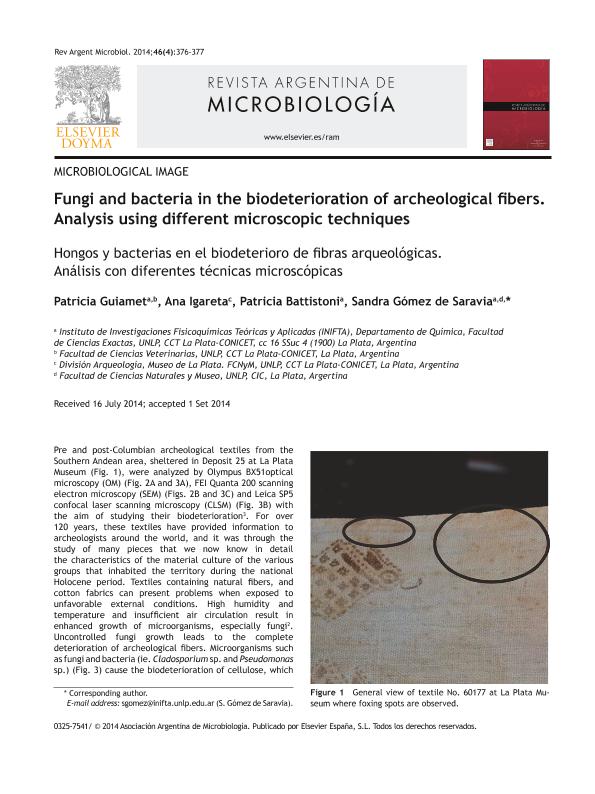Artículo
Fungi and bacteria in biodeterioration of archaeological fibers. Analysis with different microscopic techniques
Título:
Hongos y bacterias en el biodeterioro de fibras arqueológicas. Análisis con diferentes técnicas microscópicas
Guiamet, Patricia Sandra ; Igareta, Ana Teresa
; Igareta, Ana Teresa ; Battistoni, Patricia Adriana
; Battistoni, Patricia Adriana ; Gómez de Saravia, Sandra Gabriela
; Gómez de Saravia, Sandra Gabriela
 ; Igareta, Ana Teresa
; Igareta, Ana Teresa ; Battistoni, Patricia Adriana
; Battistoni, Patricia Adriana ; Gómez de Saravia, Sandra Gabriela
; Gómez de Saravia, Sandra Gabriela
Fecha de publicación:
09/2014
Editorial:
Asociación Argentina de Microbiología
Revista:
Revista Argentina de Microbiología
ISSN:
0325-7541
e-ISSN:
1851-7617
Idioma:
Inglés
Tipo de recurso:
Artículo publicado
Clasificación temática:
Resumen
Pre and post-Columbian archeological textiles from the Southern Andean area, sheltered in Deposit 25 at La Plata Museum (Fig. 1), were analyzed by Olympus BX51optical microscopy (OM) (Fig. 2A and 3A), FEI Quanta 200 scanning electron microscopy (SEM) (Figs. 2B and 3C) and Leica SP5 confocal laser scanning microscopy (CLSM) (Fig. 3B) with the aim of studying their biodeterioration3. For over 120 years, these textiles have provided information to archeologists around the world, and it was through the study of many pieces that we now know in detail the characteristics of the material culture of the various groups that inhabited the territory during the national Holocene period. Textiles containing natural fibers, and cotton fabrics can present problems when exposed to unfavorable external conditions. High humidity and temperature and insufficient air circulation result in enhanced growth of microorganisms, especially fungi2. Uncontrolled fungi growth leads to the complete deterioration of archeological fibers. Microorganisms such as fungi and bacteria (ie. Cladosporium sp. and Pseudomonas sp.) (Fig. 3) cause the biodeterioration of cellulose, which is the main component of natural fibers such as flax and cotton4. This leads to loss of strength of the natural fibers, causing odor emission, esthetic damage, the presence of staining, discoloration (foxing) and finally loss of fiber structure5, and giving rise to significant losses at economic and cultural levels. Proper storage of textiles susceptible to biodeterioration in special containers under conditions of temperature and relative humidity suitable are effective preventive measures to avoid undesirable results. Essential oils and silver nanoparticles1, among others, can be used as disinfectants for the surface of archeological fibers, historical objects and archival documents. It is essential that all tasks and strategies used in the preservation of the material be written and documented photographically, so as to keep a record for regularly assessing changes of microorganism activity leading to textile damage.
Palabras clave:
Microbiological Images
,
Fungi
,
Bacteria
,
Biodeterioration
,
Archeological Fibers
Archivos asociados
Licencia
Identificadores
Colecciones
Articulos(CCT - LA PLATA)
Articulos de CTRO.CIENTIFICO TECNOL.CONICET - LA PLATA
Articulos de CTRO.CIENTIFICO TECNOL.CONICET - LA PLATA
Articulos(INIFTA)
Articulos de INST.DE INV.FISICOQUIMICAS TEORICAS Y APLIC.
Articulos de INST.DE INV.FISICOQUIMICAS TEORICAS Y APLIC.
Articulos(SEDE CENTRAL)
Articulos de SEDE CENTRAL
Articulos de SEDE CENTRAL
Citación
Guiamet, Patricia Sandra; Igareta, Ana Teresa; Battistoni, Patricia Adriana; Gómez de Saravia, Sandra Gabriela; Fungi and bacteria in biodeterioration of archaeological fibers. Analysis with different microscopic techniques; Asociación Argentina de Microbiología; Revista Argentina de Microbiología; 46; 4; 9-2014; 376-377
Compartir
Altmétricas



